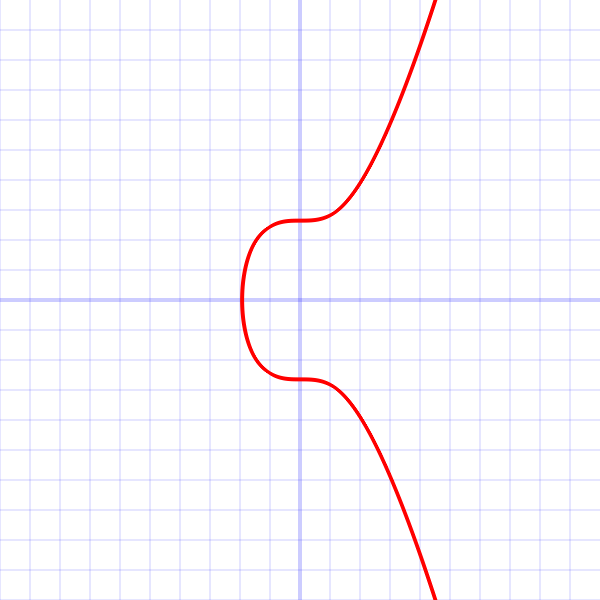Secp256k1: Difference between revisions
m Update SEC 2 link to the official site, which is back up again |
add some basic information on our favourite elliptic curve |
||
| Line 25: | Line 25: | ||
* ''n'' = FFFFFFFF FFFFFFFF FFFFFFFF FFFFFFFE BAAEDCE6 AF48A03B BFD25E8C D0364141 | * ''n'' = FFFFFFFF FFFFFFFF FFFFFFFF FFFFFFFE BAAEDCE6 AF48A03B BFD25E8C D0364141 | ||
* ''h'' = 01 | * ''h'' = 01 | ||
=== Properties === | |||
* secp256k1 has characteristic ''p'', it is defined over the prime field ℤ<sub>''p''</sub>. Some other curves in common use have characteristic ''2'', and are defined over a binary Galois field ''GF(2<sup>n</sup>)'', but secp256k1 is not one of them. | |||
* As the ''a'' constant is zero, the ''ax'' term in the curve equation is always zero, hence the curve equation becomes ''y<sup>2</sup> = x<sup>3</sup> + 7''. | |||
== See also == | |||
* [https://bitcoin.stackexchange.com/questions/21907/what-does-the-curve-used-in-bitcoin-secp256k1-look-like What does secp256k1 look like] (Bitcoin stack exchange answer by Pieter Wuille) | |||
[[es:Secp256k1]] | [[es:Secp256k1]] | ||
Revision as of 08:48, 4 August 2016

secp256k1 refers to the parameters of the ECDSA curve used in Bitcoin, and is defined in Standards for Efficient Cryptography (SEC) (Certicom Research, http://www.secg.org/sec2-v2.pdf).
secp256k1 was almost never used before Bitcoin became popular, but it is now gaining in popularity due to its several nice properties. Most commonly-used curves have a random structure, but secp256k1 was constructed in a special non-random way which allows for especially efficient computation. As a result, it is often more than 30% faster than other curves if the implementation is sufficiently optimized. Also, unlike the popular NIST curves, secp256k1's constants were selected in a predictable way, which significantly reduces the possibility that the curve's creator inserted any sort of backdoor into the curve.
Technical details
As excerpted from Standards:
The elliptic curve domain parameters over Fp associated with a Koblitz curve secp256k1 are specified by the sextuple T = (p,a,b,G,n,h) where the finite field Fp is defined by:
- p = FFFFFFFF FFFFFFFF FFFFFFFF FFFFFFFF FFFFFFFF FFFFFFFF FFFFFFFE FFFFFC2F
- = 2256 - 232 - 29 - 28 - 27 - 26 - 24 - 1
The curve E: y2 = x3+ax+b over Fp is defined by:
- a = 00000000 00000000 00000000 00000000 00000000 00000000 00000000 00000000
- b = 00000000 00000000 00000000 00000000 00000000 00000000 00000000 00000007
The base point G in compressed form is:
- G = 02 79BE667E F9DCBBAC 55A06295 CE870B07 029BFCDB 2DCE28D9 59F2815B 16F81798
and in uncompressed form is:
- G = 04 79BE667E F9DCBBAC 55A06295 CE870B07 029BFCDB 2DCE28D9 59F2815B 16F81798 483ADA77 26A3C465 5DA4FBFC 0E1108A8 FD17B448 A6855419 9C47D08F FB10D4B8
Finally the order n of G and the cofactor are:
- n = FFFFFFFF FFFFFFFF FFFFFFFF FFFFFFFE BAAEDCE6 AF48A03B BFD25E8C D0364141
- h = 01
Properties
- secp256k1 has characteristic p, it is defined over the prime field ℤp. Some other curves in common use have characteristic 2, and are defined over a binary Galois field GF(2n), but secp256k1 is not one of them.
- As the a constant is zero, the ax term in the curve equation is always zero, hence the curve equation becomes y2 = x3 + 7.
See also
- What does secp256k1 look like (Bitcoin stack exchange answer by Pieter Wuille)